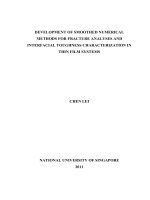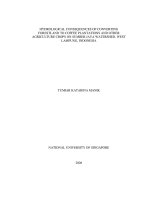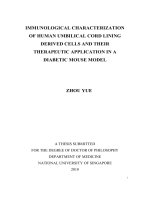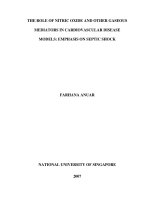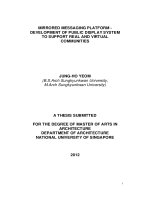Hydrological consequences of converting forested land to coffee plantations and other agriculture crops in sumber jaya watershed, west lampung, indonesia
Bạn đang xem bản rút gọn của tài liệu. Xem và tải ngay bản đầy đủ của tài liệu tại đây (4.35 MB, 299 trang )
HYDROLOGICAL CONSEQUENCES OF CONVERTING
FORESTLAND TO COFFEE PLANTATIONS AND OTHER
AGRICULTURE CROPS ON SUMBER JAYA WATERSHED, WEST
LAMPUNG, INDONESIA
TUMIAR KATARINA MANIK
NATIONAL UNIVERSITY OF SINGAPORE
2008
2
HYDROLOGICAL CONSEQUENCES OF CONVERTING
FORESTLAND TO COFFEE PLANTATIONS AND OTHER
AGRICULTURE CROPS ON SUMBER JAYA WATERSHED, WEST
LAMPUNG, INDONESIA
TUMIAR KATARINA MANIK
(MASTER OF SCIENCE, IOWA STATE UNIVERSITY)
A THESIS SUBMITTED FOR THE DEGREE OF Ph.D.
DEPARTMENT OF GEOGRAPHY
NATIONAL UNIVERSITY OF SINGAPORE
2008
i
Acknowledgement
I believe it is God who gave me the opportunity to pursue my Ph.D. degree and He
miraculously worked through people and institution that kindly facilitated and assisted
me to make my dream come true.
First, I want to say thanks to DR. Meine Van Noordwijk and the International Center
of Research in Agroforestry (ICRAF). DR. Meine encouraged me to apply to The
National University of Singapore and connected me to DR. Roy C Sidle. Being
accepted in NUS and worked with DR. Meine Van Noordwijk and DR. Roy Sidle was
really a miracle to me. ICRAF is also the institution who supported my research in
Sumber Jaya, therefore I also want to say thanks to all researchers, field workers,
administration staffs in ICRAF and farmers who worked together with me in Sumber
Jaya.
My deep appreciation is for Prof. DR. Roy C Sidle, my academic advisor, for all his
efforts, encouragements, supports, patience and suggestions during my study in NUS
especially during the thesis writing processes. I know I am not able to go through all
the processes in pursuing my degree without him. Even though I am not his best
student but I hope he still has a good thought of me.
My appreciation is also for The National University of Singapore for giving me the
opportunity to study and supporting me with all the financial supports I needed
including the research grant. I am really fortunate to be part of The National
ii
University of Singapore (NUS) especially Department of Geography. I believe NUS is
one of the best universities in the world.
Related to that, I want to say thanks both to DR. Victor R Savage and DR. Shirlena
Huang, Heads Department of Geography; Ms. Pauline Lee and all department
administration staff for their assistance during my stay in NUS. Thanks to all
academic staffs in Geography Department especially for the Physical Geography
staffs: DR. Mathias Roth; DR. David Higgitt; and especially DR. Lu Xi Xi who acted
as my interim advisor when DR. Roy C Sidle had to move to Kyoto University. Even
though I was not related much to the Human Geography section but I enjoyed the
department environment as a whole.
Thanks to all friends in Geography Department; spending time together, encouraging
each other or even just meaningless talk were part of my study time in NUS that I
consider valuable. To DR. Junjiro Negishi and his wife Miho, first friends I had in
Singapore; to Zhu Yun Mei; Li Luqian; Joy Sanyal; Gu Ming; Desmond Lee; May
Mullins; Zhang Shurong; Su Xiaobo; Winston Chow; Lim Kean Fan; Ong Chin Ee;
Tricia Seow; Albert Wai; Sarah Moser and Fanny. I have to admit that I am not good
in keeping in touch with all friends; but trust me I always keep the memories.
Thanks also to other friends I met and have in Singapore: To Mary Kwan, a friend who
helped me a lot in getting to know Singapore; Elsje Kadiman; Fitriani Kwik; Lina,
Wiwik, Henri and all friends in Pasir Panjang.
iii
In Lampung I want to say thanks to Prof. DR. Muhajir Utomo, former president of
Universitas Lampung; Prof. DR. Tirza Hanum the vice president who allowed me to
leave the campus for this study. To DR. Hamim Soedarsono, former Dean of
Agriculture Faculty and DR. Erwin Yuliadi and DR. Paul B Timotiwu former Heads of
Agronomy Department who kept encouraging me in finishing my study.
To my colleagues in Climatology peer group: DR. Agus Karyanto, Syamsoel Hadi
MSc, Eko Pramono MS, DR. Muhamad Kamal; Herawati Hamim MS who kept the
Climatology teaching program run well during my left.
Thanks to Rev. DR. Sutoyo L Sigar and the congregation of Karunia Tuhan Baptist
Church in Lampung for the prayers and the friendship that constantly strengthen me.
Thanks also to Syamsudin and Susan Then, Susy and Ben Liong; Pastor and Mrs.
George Hatfield for the long distance friendship and prayers you did for me.
Special thanks to DR and Mrs. John Chambers. The marvelous couple God gives me;
who are always on my side since my undergraduate time until now. They help and
lead me in all aspects of my life and I know I become like me now because of their
ministry in my life.
Finally, I want to give my deep appreciation to my family: Ibu; Bang Binsar,Ui and
Sardo; Sam, Muti and Marcel; Bona, Nining and Eldo and Nina. You all are my
precious treasures in this life and I love you all.
iv
SUMMARY
Sumber Jaya (54,194 hectares) is a district in West Lampung, Indonesia. Sumber Jaya
is located at the upper part of Tulang Bawang watershed, known as Way Besai
watershed and this watershed is a major water resource for Lampung Province.
Sumber Jaya has recently become a focal point of discussion because of the
widespread conversion of forestland to coffee plantations and human settlements and
the associated environmental and hydrological problems. This research aimed to
evaluate Sumber Jaya watershed condition affecting by rapid land cover change using
hydrological methods. The evaluation will include investigating rainfall spatial and
temporal distributions as the input to the watershed and rainfall-runoff relation using
different methods. There were two parts of data for investigating the effect of land use
change on hydrological processes in Sumber Jaya watershed. Previous study used
secondary daily and monthly data of rainfall and water discharge from 1984 – 2002;
while field work has been done in 2005 to directly investigating rain distribution and
its relation with water discharge. To obtain a numerical measure of closeness pattern
between rain gages and between rain and water discharge, correlation coefficients were
calculated. From the field work data analyses expanded to calculate rain time
displacement and spatial distribution; while rainfall – water discharge analysis
included hydrograph analysis, unit hydrograph and scaling factor.
To determine the values of time-displacements (temporal scale), auto-correlation of
rainfall data from each gage was calculated. The auto-correlation with increasing time
lags were calculated until they had the closest values to the cross correlation. Spatial
distribution of rainfall was analyzed by kriging techniques. General rainfall-discharge
v
correlations were calculated by coefficient correlations of the continuous time series of
the rainfall and discharge. Also, stream discharge and rainfall during individual storms
in each catchment were plotted and quantitative hydrograph analysis was calculated.
Unit hydrograph was used to calculate discharge from a given excess rainfall. First,
unit hydrograph in this study was computed by IHACRES model. IHACRES
expressed the relationship of rainfall and runoff in: peak response, recession rate, time
constant and relative volume of quick and slow flow. Second, linear spatially
distributed model will be applied to investigate the outflow hydrograph from
catchment series. Third, unit hydrograph for a catchment can also be constructed from
observations of input and response for several significant storms of approximately
equal duration.
From the analysis of rainfall distribution it can be concluded that rainfall in Sumber
Jaya is distributed heterogeneously and probability of getting heavy rainfall was lower
than light rainfall. Most of the rain was convective rain which was short and local.
Therefore, it can be concluded that rain in this area should not consider as the only
factor causing environmental problem such as flood and land slides in this area. For
ordinary conditions, rain did not fall homogenously over the entire catchment area. In
the lower part of the catchment the intensity was moderate (42 mm/day) during the dry
season and (61.2 mm/day) at the beginning of the rainy season, while in the mountain
area rain fall at higher intensity (101.4 mm/day) during the dry season and (113.6
mm/day) at rainy season. Rain intensity might increase extensively following
climatic cycle (i.e. every 5 years), for example in 2002 rain intensity was 150 mm/day.
vi
From the time series analysis of rainfall – water discharge in the period of 1984-2002
it can be concluded that water discharge did not follow the pattern of rainfall; soil was
able to hold the water before it flew to the river. The field work in 2005 resulted that
most of the stormflow from these catchments consisted of slow flow. A maximum of
about 50% of the effective rainfall became quick flow, and only 1 to 10% of remaining
effective rainfall which was routed as slow flow contributed to hydrograph peaks; the
rest was stored. Comparing peak responses and recession rates, stormflow discharge
was generally increased more slowly on the rising limb of the hydrograph and
decreased more rapidly on the falling limb. This response pattern indicates that the
soils in these catchments were able to hold and store rain water.
vii
Table of Contents
Page
Acknowledgement ……………………………………………………….i
Summary…………………………………… …………………………………… iv
List of Tables …………………………….………………………………… … xi
List of Figures……………………………………………………… …….… …xiv
Appendices ……………………….…… ….………………… ….…. xvi
I. Introduction ………………………………………………………………………1
I.1 Research Background 1
I.1.1 Forest Conversion in Indonesia ….……… … ………………… ……2
I.1.2 Forest Conversion in Sumber Jaya ……… … …….………………… 6
I.2 Research objectives … 18
II. Literature Review ………… ……….…….……………………………… 21
II.1 Spatial and Temporal Distribution of Rainfall ………….………….……………21
II.2 Predicting Water Discharge from Rainfall-Runoff Correlation…… … ………29
II.3 Roles of Drainage Area on Water Discharge …………………….….………… 35
viii
II.3.1 Simple scaling invariance in the flood peaks ……………….…………… 39
II.3.2 Multi scaling invariance in the flood peaks ……………….……………….42
II.4 Hydrograph Analysis in Interpreting Land Covers Effects on Water Discharge .46
II.5 Historical and Current Socio-Economic and Policy Influences on Land Cover and
Watershed Conditions in Sumber Jaya……… ……… 58
II.5.1 Land use policy and history of Sumber Jaya 58
II.5.2 Current Sumber Jaya land covers condition and socio economic
pressures 61
II.5.3 Community forest scheme (HKm= hutan kemasyarakatan); land tenure
as environmental service rewards ……………………………………… 64
III. Methods ……………….……………………………………………………… 70
III.1 Description of the Research Site ……………………………………………….70
Land use changes in Sumber Jaya ……… … 73
III.2 Rainfall and Runoff Monitoring Sensors and Instruments … 79
III.3 Data Analysis … 84
III.3.1 Statistical analysis of Sumber Jaya daily and monthly rainfall
data (1974 – 2002) ………… ……………………… ……….84
A. Measures of central tendency, dispersion and symmetry….…84
B. Probability distribution ……………………………… ……85
ix
III.3.2 Statistics analysis of Sumber Jaya rainfall data (July – December 2005)… 87
A. Rainfall temporal distributions ….………… ………… 87
B. Rainfall spatial distributions …………………… ……….88
III.3.3 Statistical analysis of daily rainfall –water discharge
relationship (1975- 1989) ……………………………………………………89
A. Rainfall-discharge coefficient correlation. ………… … ……89
B. Time series of rainfall-discharge relationship ……… … …… 89
III.3.4 Rainfall- Water Discharge Relationship (July – December 2005) .….…… 90
A. Rainfall-discharge coefficient correlation… ……… ………….90
B. Hydrograph Analysis ………… …… ……… …………….….91
III.3.5 Unit Hydrograph ……….……… …………………….……… ……….….92
A. IHACRES model…………………….….… … ………… ……92
B. Linear spatially distributed model …………… …………… …95
C. Determination from observations ……….……………… ……98
III.3.6 Catchment scale factor………………………………………… ……….99
IV. Results and Discussions …………………………….……………… … 102
IV.1 Rainfall analysis … ………………… …….……………… …………….102
IV.1.1 Rainfall temporal distribution…………….….…… …….…………102
IV.1.2 Spatial distribution of rainfall …………….………………….… …108
IV.1.3 Rain depth ……………… ……………….……….… …… …….114
x
IV.2 Rainfall- runoff relation ……………………………………… ……… ……119
IV.2.1 Coefficient correlation …………………………… ……………. 119
IV.2.2 Storm hydrograph analysis ………………… ……….….…………126
IV.3 Unit hydrograph ……………………………… … ……………………….134
IV.3.1 Unit hydrograph estimated by the IHACRES model……… … … 136
IV.3.2 Unit hydrograph estimated by the linear
spatially distributed model ……… ……………… …………….…147
IV.3.3 Unit hydrographs estimated from several observations …… … 150
IV.4 Area scaling factor ……………………………………………………….… 156
IV.5 Results from previous study …………………………………………… … 164
IV.5.1 Rainfall distribution …………………………………… … …… 164
IV.5.2 Rainfall – water discharge correlation ……………….… … …… 171
V. Conclusions…………… ………… …………………………….…………178
VI. Recommendations …………….…………….……… ………….…………191
VII. Bibliography ……………………… ….……………………… ….……….196
xi
List of Tables
Table 1.1 Tropical forest area in 2000 (thousands of hectares) and
average annual change (%) in forest area (1990-2000) ….……….……….3
Table 3.1 Land cover changes in Sumber Jaya Catchment
in 1973 ………………………… ……………………….….…… …….74
Table 3.2 Land cover changes in Sumber Jaya Catchment
from 1986 to 2001 …………………………………….….……… …….75
Table 3.3 The area and elevation of the study catchments …………… ………….76
Table 3.4 Dimensions of standard Parshall Flumes …………………………… ….83
Table 3.5 Discharge Characteristics of Parshall Flumes ……………………………83
Table 4.1 Daily average cross-correlation from one gage
to the rest of the gages ………….…………………… …….….……….103
Table 4.2 Average correlation coefficient and distance (m) between catchments (shown
in parentheses) for all major rain events combined …… ……….103
Table 4.3 Time lags between catchments with lowest correlation to approximate
the longest time lag …………………………………………………… 104
Table 4.4 Distance between rain gages around Sumber Jaya
catchments with coefficient correlation ≥ 0.5 …………… …………… 107
Table 4.5 Values of sill and length as well as the locations of the center of rainfall
derived from the spatial distribution of the major rain events
presented in Figures A.2. – A.6. …………………………… …… … 110
Table 4.6 Values of sill, length and centre of rainfall from the spatial distribution
presented in Figures A.7 – A.10 ………….………… …………………112
Table 4.7 Daily rain depth (mm) of each catchment for every rain event … …… 115
xii
Table 4.8 Rain depth (mm) of rain gages around Sumber Jaya
watershed for every rain event …………………………….…………… 116
Table 4.9 Maximum rainfall in a 10 min period of each storm……….……………117
Table 4.10 Daily rainfall (mm) estimated for storms with various return period at
stations around Sumber Jaya catchment (data are from 1972 – 1998)… 118
Table 4.11 Rainfall-runoff cross correlation and delayed time (min)
during certain rain event ……….…………………………….……….…120
Table 4.12 Time analysis of individual runoff hydrograph ………… ……… …. 127
Table 4.13 Rain - runoff analysis for individual storm
event in each catchment ……………………………………….….……129
Table 4.14 IHACRES cross correlation between observed and
modelled water discharge for every catchment for the
two periods of data …………….………….…………….……… …… 136
Table 4.15 Parameters from IHACRES model both for
catchments presented as lumped and as nested catchments …….… …138
Table 4.16 Storage constant calculated from linear model (Figure A.18.)
and the regression coefficient between observed
and predicted discharge ………………… …………… ……….…… 148
Table 4.17 Quantitative description of unit hydrographs in Figure. A.20. … ….…151
Table 4.18 Discharge rate (m
3
/s) in each catchment with catchments listed in
order of increasing area ……… ………………………………………157
Table 4.19 Locations, length of data records and distances of rainfall
gages from the center of the Sumber Jaya watershed………………….164
Table 4.20 Central tendency, dispersions and symmetry of Sumber Jaya rainfall 166
xiii
Table 4.21 Distribution parameters and correlation coefficient of calculated
and predicted daily rainfall data …………………………… ………168
Table 4.22 Distances between stations (km) and coefficient correlation between
rainfall monthly data in Sumber Jaya ……………………… ……… 171
Table 4.23 Cross correlation of daily rainfall and stream discharge for
stations inside Sumber Jaya watershed (1975 – 1999) …… ….…… 172
Table 4.24 Coefficient correlation between monthly rainfall and river
discharge from rain and stream gauges in Sumber Jaya watershed ….172
xiv
List of Figures
Figure 2.1 The three climate regions according to the mean annual
patterns using the DCM. Indonesia is divided
into Region A (solid line), Region B (short dashed line)
and Region C (long dashed line)
(from Aldrian and Susanto, 2003) ……………………….……… ………23
Figure 3.1 Indonesia map. Lampung Province is on the South tip of
Sumatra Island ……….………………………….……………………….71
Figure 3.2 Sumber Jaya catchment and the mountains surround the catchments
where rain gages were installed ……………… ……………………… 72
Figure 3.3 The nested catchments of the study area …………………… ….………77
Figure 3.4 Land cover in the nested catchments ……….…………… …………… 78
Figure 3.5 Rain gages were installed on the hill borders of the nested catchments…79
Figure 3.6 Parshall flume for catchment 1, Agroforest and forest
with the size throat width 0.305 m ……………………………….….….80
Figure 3.7 Parshall flume for catchment 3 and 4 with
the size throat width 0.61 m ……………………………………………80
Figure 3.8 Parshall flume for catchment 5 with the size throat width 1.83 m … …81
Figure 3.9 Rectangular weir for catchment Way Besai ……………………… ….81
Figure 4.1 Total discharge ratio increases with increasing
catchment size ratio ……………………………… ……….………….159
Figure 4.2. Discharge probability density function from
catchment WB (the largest catchment area) ……………… . …………161
xv
Figure 4.3 Time constant for all catchments during all storm
events (a) without including catchment WB and
(b) with catchment WB …………………………… ……………….… 162
Figure 4.4 Linear regression between catchment size and time constant …….……163
Figure 4.5 Comparison of probability distribution of monthly rainfall
data from stations in Sumber Jaya watershed (a) calculated
and (b) the normal distribution ………………………………………167
Figure 4.6 Comparison of probability distributions of daily rainfall
data from research plots in Sumber Jaya watershed (a) calculate and (b)
based on the Gamma distribution …………… ………………… …168
Figure 4.7 Comparison of probability distribution of daily rainfall
data in Simpang Sari for different period of years (a) calculated
and (b) based on the Gamma distribution ………………………….…169
Figure 4.8 Comparison of probability distributions of daily rainfall
data in Bodong Jaya for different period of years (a) calculated
and (b) based on the Gamma and exponential distributions ….… …170
Figure 4.9 Correlograms of 5-yr period of daily precipitation series starting in
1975 and countinuing through 1994 at Sumber Jaya. Straight lines
showed the upper and lower probability limits at the 95 % level … 174
Figure 4.10 Correlograms of 5-yr period of water discharge series from
the Way Besai River at Sumber Jaya starting in 1975 and
countinuing through 1994. Straight lines showed the upper
and lower probability limits at the 95 % level ………………… … 176
xvi
Appendices
Figure A.1 Temporal rain distribution within the research catchments .…….… 213
Figure A.2 Rainfall spatial distributions of the catchments
area on 19 July 2005 … ……………………………… ……….… …215
Figure A.3 Rainfall spatial distributions of the catchments
area on 22 August 2005 ……………………… ………… ….……216
Figure A.4 Rainfall spatial distribution (mm in 10 min steps) of the catchments
area on 25 September 2005 ………… … …………………… …220
Figure A.5 Rainfall spatial distribution (mm in 10 min steps) of the catchments
area on 26 October 2005 …… …… ……………………….… ……222
Figure A.6 Rainfall spatial distribution (mm in 10 min steps) of the catchments
area on 18 November 2005 …… ………………………… … ……226
Figure A.7 Rainfall spatial distribution (mm in 10 min steps) of the Sumber Jaya
area on 4 January 2006 ………………….….………………………229
Figure A.8 Rainfall spatial distribution (mm in 10 min steps) of the Sumber Jaya
area on 9 January 2006 …………………………… ………………234
Figure A.9 Rainfall spatial distribution (mm in 10 min steps) of the Sumber Jaya
area on 10 January 2006 ……………………….…….………………238
Figure A.10 Rainfall spatial distribution (mm in 10 min steps) of the Sumber Jaya
area on 12 January 2006 ………………………………….………….242
Figure A.11 Runoff hydrographs on individual event of each catchment … … …246
Figure A.12 Time series of stream discharge for each catchment
treated as lumped catchment .……………………………………… 250
xvii
Figure A.13 Time series of stream discharge for each catchment
treated as nested catchment .………………………………… …… 253
Figure A.14 Water discharge predicted by IHACRES for
2 August event, catchment treated as lumped …………….…… ….…256
Figure A.15 Water discharge predicted by IHACRES for
2 August event, catchment treated as nested ………….……….…… 259
Figure A.16 Water discharge predicted by IHACRES for
the 7 December event, catchment treated as lumped ………… … 261
Figure A.17 Water discharge predicted by IHACRES for
the 7 December event, catchment treated as nested …… … …… …265
Figure A.18 Water discharge rate estimated by linear distribution for
2 August and 7 December events …………………… ……….………267
Figure A.19 Unit Hydrograph of 1 mm rainfall for each catchment from several
events ……………………………………………………… …… …270
Figure A.20 Peak responses (a) and recession rate (b) of each catchment
(from the unit hydrograph on Figure A.19)………………… ………272
Figure A.21 Comparison of water discharge series from
all catchments for different periods and comparison
of total discharge ……………… …………….…………….………….276
Figure A.22 Total discharge increasing linearly with increasing
catchment size …………………………….………………… …… 280
1
I. Introduction
I.1 Research Background
Land use changes have been continuous since the beginning of civilization, especially
for agricultural activities (e.g., Bellot, et al., 2001). Changes in land use and resulting
land cover throughout the world have caused important effects on natural resources
through deterioration of soil and water quality, loss of biodiversity, and in the long-
term, through changes in climate systems. This situation has stimulated research that
aims to better understand the factors driving land use and cover change and the effects
of these changes on the environment (de Koning et al., 1998).
Even though land use change is occurring in many places of the world, the greatest
concerns are in tropical forests because these areas have many important functions.
Tropical regions and their forests provide a major control for regional and global
climate. Examples of services supplied by tropical forests include: (1) habitat and
homes for many life forms, including local and indigenous people; (2) sources of
timber and pharmaceutical products; (3) carbon sinks; and, most importantly, (4)
maintenance of natural ecosystem services (Salati and Vose, 1984; Janzen, 1986;
Balick and Mendelshon, 1992; Alcorn, 1993; Fearnside, 1997; Laurance, 1999).
However, the destruction of tropical forests continues. At the global scale, an average
of 15.4 million ha of tropical forests is destroyed each year, while another 5.6 million
ha is logged and converted to another forest cover. The net rate of forest conversion
(21 million ha/year) implies that about 1.2% of all remaining tropical forests are
cleared or logged annually. In total, the American tropics have the highest area of
2
forest conversion, but since tropical forests in Asia are more limited, these forests have
the highest relative rate of conversion and logging (Laurence, 1998; Laurence, 1999;
Leopold, 2001).
At the local and regional scales, forests are crucial for maintaining the stability of
rivers and watersheds. National and regional concerns for forest conversion and
reforestation most often focus on the loss of the watershed functions of natural forests.
The loss of watershed functions can be a combination of on-site concerns such as loss
of land productivity because of erosion, off-site concerns related to water quantity
(annual water yield, peak/storm flow, dry season base flow and ground water
discharge) and concern about water quality including siltation of reservoirs
(Krairapanod and Atkinson, 1998; Susswein et al., 2000).
I.1.1 Forest Conversion in Indonesia
According to data presented by the NGO “Global Forest Watch” (Matthews, 2002),
Indonesia is one of the five countries in the world with the richest tropical areas.
However, Indonesian forests also have the highest rate of area change (Table 1.1).
Forest exploitation in Indonesia began in the early 1970’s due to development of the
wood processing industry. Today, Indonesia is a significant producer of tropical
hardwood logs, saw wood, plywood, other dimensional lumber, and pulp for
papermaking. More than half of Indonesia’s forests, some 54 million hectares, are
allocated for timber production (although not all are being actively logged), and a
further 2 million ha of industrial wood plantations have been established, supplying
3
mostly pulpwood. After only two decades of timber extraction in Indonesia, the vast
natural forests have been severely degraded. The Indonesian government tried to solve
this problem by implementing regeneration systems: TPI (Indonesian Selective
Cutting) which was later replaced by a modified system, TPTI (Indonesian Selective
Cutting and Planting). However, both of these systems did not address the underlying
problems. Instead, illegal logging became a more common practice and industrial
logging together with the introduction of agricultural plantation crops including tea,
coffee, rubber, and oil palm are major causes of forest conversion in Indonesia.
Table 1.1 Tropical forest area in 2000 (thousands of hectares) and average annual
change (%) in forest area (1990-2000)
Country Forest area
Average annual
change
Brazil 543,905 -0.4
DRC 135,207 -0.4
Indonesia 104,986 -1.2
Indonesia (GFW estimate 1997 data)
98,255 -1.7
Angola 69,756 - 0.2
Peru 65,213 - 0.4
Source: Global Forest Watch (2000)
Forests are one of the natural resources of Indonesia that should be used for national
development. However, a corrupt political and economic system has caused forest
conversion without maximal results. For example, nearly 9 million ha of land, much of
4
it natural forest, has been allocated for development as industrial timber plantations.
This land has already been cleared, yet only about 2 million ha of land have been
planted with fast-growing species, mostly Acacia mangium, to produce pulpwood. The
implications have been that 7 million ha of the former forestland lies idle, nearly 7
million ha of forest was approved for conversion to estate crop plantations by the end
of 1997, and this approved land has almost certainly been cleared. However, the area
actually converted to oil palm plantations since 1985 is about 2.6 million hectares,
while new plantations of other estate crops probably account for another 1-1.5 million
ha. These statistics imply that 3 million ha of the former forestland lies idle, while no
accurate estimates are available for the area of forest cleared by small-scale farmers
since 1985, but a plausible estimate in 1990 suggested that shifting cultivators might
be responsible for about 20 percent of the forest loss. This would translate to clearance
of about 4 million ha between 1985 and 1997. Large-scale plantation owners have
turned to the use of fire as a cheap and easy means of clearing forests for further
planting. Deliberate burning, in combination with unusually dry conditions caused by
El Niño events, led to uncontrolled wildfires of unprecedented extent and intensity.
More than 5 million ha of forest burned in 1994 and another 4.6 million ha burned in
1997-1998. Some of this land is regenerating as scrub forest and small-scale farmers
have colonized other portions of this land, but there has been little systematic effort to
restore forest cover or establish productive agriculture areas. Another contribution to
forest degradation in Indonesia was the transmigration program that relocated people
from densely populated Java to the outer islands. This program was responsible for
about 2 million ha of forest clearance between the 1960s and 1999 when the program
ended. Thus, in general, Indonesia loses nearly 2 million ha of forest annually
(Matthews, 2002).
5
The consequences of these activities are obvious. A report from the Indonesian
government, National Coordination Board for Natural Disaster relief, and UNHA
(United Nations, Department of Humanitarian Affairs) showed that at least 18 disasters
related to floods and landslides occurred in various places between 1984 and 2003.
Fatalities were common in these disasters.
Forest distribution on Indonesia's main islands is uneven. Forests cover more than 47%
of Sumatra, although coverage ranges from 30.6% in Southern Lampung to 68.6% in
West Sumatra. Similar to most of Indonesia, Sumatra faces problems related to forest
conversion. The two major causes of land use change/forest conversion in Sumatra are
transmigration projects and the opening of land for crop plantations.
Since the beginning of the 20
th
century, the Dutch colonial government commenced a
project aimed at establishing “colonies” of settlers from Java in the other islands. The
need to relieve population pressure in Java motivated this project; on the other hand,
this project also helped the Dutch companies to obtain cheap labor for their
plantations, which they started to open in Sumatra. Most of the first Dutch settlements
were built near Lampung in Southern Sumatra. From 1905 to 1940, 173,959 migrants
from Java settled in Lampung. The transmigration project continued under different
names after Indonesia gained independence; this reflected the government’s
uncertainty and lack of preparation. The only guiding concept was that Java’s
population problems could be solved by transferring people to the other islands in
Indonesia (Hardjono, 1977). In reality, many problems arose after the transmigration
projects, especially in Lampung, as this area continued to be the focus of the project. A
census in 1930 indicated that 36.2% of the total population in Lampung (361,000) was
6
people from different areas in Java. In 1971, this figure increased to two-thirds of the
total population (2,777,085). The government did not sponsor some of the migrants;
some were independent settlers who migrated of their own free will (Hardjono, 1977).
Eventually, the population in the settlement area became too dense; finally, in 1986,
the provincial government of Lampung closed the province to immigrants. The entire
project was originally planned as an irrigated-rice settlement, but the government
failed to provide the necessary irrigation system. Furthermore, not all farmers had the
skills to convert land to wet-rice cultivation. This condition forced immigrants to plant
cassava since dry-rice yields were too low to sustain their livelihood. Additionally,
farmers subsisted by moving out from the settlement areas and opening or purchasing
land in the surrounding area. Since no land deeds were ever issued to the immigrants,
disputes over land claims occurred (Hardjono, 1977). Consequently, the transmigration
project, which led to a population increase in Lampung from 2,456,000 in 1971 to
5,318,000 in 1990, and more than 6.7 million in 2001 (Pemda TK I Lampung, 1992;
BPS Propinsi Lampung, 2001), was the major initial driving force of land use changes
in Lampung Province.
.
I.1.2 Forest Conversion in Sumber Jaya
Sumber Jaya is a district in West Lampung, Sumatra. The long mountain range in
Sumatra, Bukit Barisan, runs north to south on the western side of Sumatra and
Sumber Jaya is located at the end of this range. Sumber Jaya (54,194 hectares) is
located at the upper part of Tulang Bawang watershed, known as Way Besai
watershed. Tulang Bawang River drains an area of 998,300 ha which consists of four



